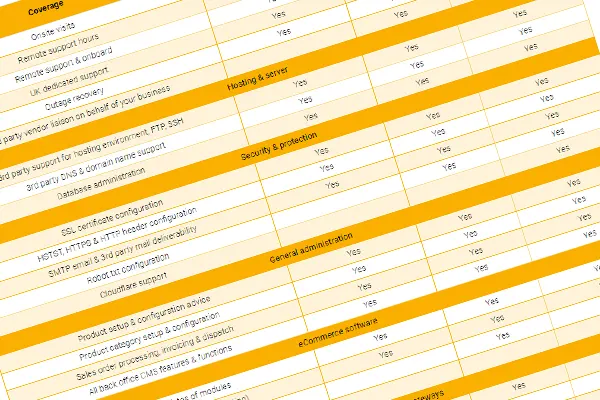Emma Taylor-Lane
8 December 2022
eCommerce


Top tips for managing eCommerce multichannel selling
So you have a website for your embroidery, print, workwear or schoolwear business. Having a strong website is the bare minimum for an eCommerce company. And it may be performing well, but by limiting your business to just one sales channel is limiting your potential sales. We live in a world of multiple shopping channels, which has dispersed your potential customer base. Making your products available on selling platforms, such as eBay and Amazon, exposes your business to many more potential customers and increases your chances of making sales. But before jumping into multichannel selling, you need to understand what you’re getting into, and how you can make the most of it. Let’s look at the benefits of multichannel selling, the challenges, and how you can take advantage.What is multichannel selling?
Most simply put, it is the process of using multiple sales channels to sell your goods to your customers. It can include bricks and mortar stores, multi-vendor spaces such as craft fairs, and online channels including a website and presence in online marketplaces. In this article, we will concentrate on online selling.
Types of channels
When it comes to channels, there a number of options availableYour eCommerce site
First and foremost, is your own eCommerce site. Ideally, it should offer online design tools, direct purchasing, and easy checkout. Good eCommerce software combined with apps such as Shopify, will enable you to offer your clients these services.Online marketplaces
This is a broad category, which includes Amazon, eBay, Etsy, and Reverb. While Amazon specialises in warehousing arrangements it, like the others, also allows retailers to be in charge of order fulfilment, including shipping and handling. They offer a layer of protection between the retailer and the purchaser, providing customer service. However, should you fail to meet their standards, you can have your account closed.Comparison portals
These are less obvious than the first two options, but for price-conscious shoppers, they may start with a comparison site, such as Google Shopping. Here, users can compare prices and products from sites around the world.Social media marketplaces
Many larger brands use social media platforms such as Facebook, Instagram, Pinterest and Twitter to promote their products and promotions. Even smaller businesses can make the most of social media networks to boost sales and brand awareness.Why multichannel eCommerce?
There are a number of benefits of multichannel selling. We’ll look at some of them here.Larger customer base
The more channels you sell on, the greater the potential audience. The greater the potential audience, the greater the number of sales that result. It also lets your customers shop where they feel most comfortable, whether that’s from your eCommerce website, or through a giant retailer such as Amazon.Improved revenue generation
When you take advantage of multiple marketplaces and expand your potential customer base, you’re more likely to find people who want to buy your products, which improves your revenue generation.Brand building
In this digital age, people are always searching online for a better deal. Personalisation is a price sensitive market, and they will check out various marketplaces. But when a potential customer comes across your branding on multiple sites, they feel that you’re more reputable and are more likely to be trustworthy. This mirrors the typical buying journey, where potential customers need to feel familiar with a product before purchasing.Organic traffic
Organic traffic is where your site appears in the results of search engines. When you have multiple selling platforms, you’re more likely to appear in search engine results. And the great thing is that organic traffic is free. So, when you list on Amazon or eBay, people will see the name of your own business and, over time, and after great service and high-quality products, will seek out your organisation specifically, building your brand and driving traffic to your website.Competitive edge over your rivals
If you’re selling on multiple sites and your competitors aren’t, you’ve automatically got a competitive edge over them. As already mentioned, you’re hitting a wider audience and building your brand. That means you become more recognisable to potential customers as well as giving yourself more opportunities to make a sale.Make the most of established marketplaces
Building an eCommerce store isn’t cheap. But, even if you don’t have the budget for an all-singing, all-dancing eCommerce website, there’s no reason you can’t take advantage of existing marketplaces, such as Amazon and eBay. These massive, globally-recognised selling sites invest substantially in the latest AI tools and machine learning development to understand how users browse and purchase from their site. Listing on these sites also gives your business greater credibility through these sites’ existing reputations.
How challenging is multichannel eCommerce to implement?
Well, multichannel eCommerce does have its challenges; there’s no ignoring that fact. But with all the advantages it offers, they are challenges worth dealing with.The right marketplaces
Firstly, choose the right platforms. Some sites are better suited to your particular business than others. Etsy is great for personalised items, for example, while Amazon may be less suitable. There may be other specialist sites that will generate more business for you than generic ones.Account management
Selling across multiple platforms means having to maintain a business relationship with a range of different companies. They each have paperwork that needs completing and compliance standards that need to be met. This can be time-consuming and require significant ability to juggle differing demands.Time management
More channels means more time managing them. This includes uploading products, managing orders, shipping, inventory management, etc. While some organisations outsource their multichannel eCommerce management to an expert, the right eCommerce back-office systems can handle orders from multiple channels, simplifying the whole process for an efficient, end-to-end process.Inventory management
Stock management is key to a successful personalisation business. It needs to be kept up-to-date across all channels. Over-stocking, under-stocking or simply not knowing your stock situation can all impact your bottom line. What if two orders arrive simultaneously for the same product, and you don’t have enough? There are tough decisions to be made about which order to prioritise, and your reputation can be damaged. Again, an effective eCommerce back-office system that automatically updates stock levels, and provides extensive business intelligence, can help with all of this.Human error
The more human interaction that is required during a process, the greater the risk of human error. The more integrated your systems, the better. An eCommerce system that integrates with software such as Shopify, accounts packages, and ERP systems, reduces the chance of mistakes.Managing the customer experience
When you’re selling products across an array of websites and online marketplaces, you’re losing control of elements of the customer experience. While your product quality remains in your hands, other aspects are out of your control. Poor customer service by a third party reflects badly on your brand, as consumers may not be aware that someone else is responsible for handling their initial enquiries.Managing multichannel selling
Whatever channels you choose, your goal remains the same: make sales and increase profits. That’s why choosing your channels is vital. Do your research. Analyse each potential marketplace carefully, checking out their history and audience base. Do they match your target market?Analytics
Once you’ve selected your marketplaces, check your analytics carefully. Even if listing is ‘free’, each channel is costing you money in terms of time and effort. That’s why you need to ensure that you’re tracking your results on a very regular basis.Sales strategies
Each online channel is unique. They may operate differently and, of course, have different sets and types of customers. You’ve done your research and checked your analytics. Now it’s time to tweak your sales strategy for each marketplace. Examine the analytics, check out your audience, and tailor your message accordingly.Strive for consistency
This may seem counterintuitive to the message above, but you should keep your branding the same across all platforms. This means that wherever your customers are buying from, they can be confident of the same quality of product.Don’t overreach yourself
It’s tempting to list your products on every available marketplace, especially if you only pay fees for what you sell. However, you need to be realistic about whether you can service that many different channels effectively and efficiently. This is especially important for major brands like Amazon, which have extremely struct standards for order fulfilment.Inventory management
We’ve already talked about the importance of stock management. Poor stock management can not only affect your profits but also your reputation. That means understanding your stock position at any given time. You need to know that you can meet your orders when they’re placed. Failure to provide the products ordered within a timely manner will affect your reputation. Customers will respond with feedback that reflects their experience, positive or negative. Negative reviews, especially if they’re more prevalent, can have a real impact on your business. Why not check out our previous post on managing multiple product lines?Demystify Digital
If you’re looking to expand into multichannel selling, you need the right eCommerce website and software to manage the process effectively and efficiently. With over two decades’ experience of the personalisation industry, Demystify Digital understands the specific challenges of the sector. Our bespoke websites and unique SaaS – specifically designed for the personalisation market – are ideal for any print, embroidery, engraving, workwear or schoolwear companies looking to expand their business. For more information on how we could help your organisation develop your multichannel business, why not book a FREE one-hour consultation? We can be contacted on 01903 372 402 or email us at [email protected]. Tag Post : Share This :Recent Post
- 08 Dec 2022 Top tips for managing eCommerce multichannel selling
- 28 Nov 2022 Tips for managing a large product base
- 15 Nov 2022 Effectively manage both B2C and B2B orders
Categories
Book a meeting today!
Think or can help or need to talk? Book an online Teams meeting today or call 01903 372 402- Proven record working with businesses up to £50m turnover
- Simple approach that’s process driven by ISO 9001
- Deep experience in Enterprise eCommerce platforms
- UK based team to help support your business needs
Tagged B2B, B2C, business, eBay, ecommerce, embroidery, ERP, etsy, garment personalisation, integration, multichannel selling, online, personalisation, print, SaaS, schoolwear, website sales, workwear